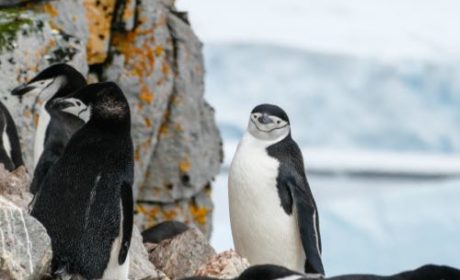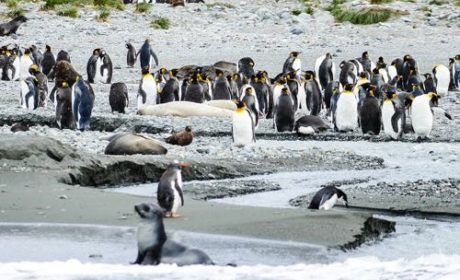We hadn’t head of Neumayer Channel until the day we cruised through it on an Antarctica cruise. What a beautiful surprise this travel experience turned out to be.
When Alan and I cruised in Antarctica on Seabourn Quest, we expected to see mammoth icebergs, stunning scenery, and cute penguins waddling around. But the other worldliness of Antarctica’s light came as a complete surprise to us.

After a sunny day of penguin watching on Cuverville Island, we didn’t think our cruise could get any better. But then the Quest entered Neumayer Channel.
The soft, golden rays shining low in the sky added a dimension beyond scenery and wildlife that’s hard to explain. And cruising the Neumayer Channel at the end of a sunny, Antarctica day was worthy of an addition to our travel bucket list.

The Neumyaer Channel winds like a maze for 16 miles in the Palmer Archipelago of Antarctica. The narrow channel, about 1.5 miles wide, separates Anvers Island from Wiencke Island and Doumer Island. Because of Neumayer’s inverted S shape, no exits are visible giving the journey an up close and personal feel.
Boomer Travel Tip
In today’s travel climate, trip insurance is a must. Compare policies and rates at InsureMyTrip.

Seabourn Quest enters Neumayer Channel through a sharp bend. From Deck 11, where the photographers hang out at the bow of the ship, steep cliffs of the channel seem close enough to touch. A wind blows snow across the mountaintops while down below in the water, glints of blue hide in the crevices of icebergs.
Boomer Travel Tip
Check out our itinerary and experiences on an Antarctica Cruise.

A distant roar wafts over the sound of Quest’s engine. Everyone quickly looks for signs of a calving glacier. But this time, it‘s an avalanche of snow plowing across a steep slope.

The crystal-clear atmosphere combines with late afternoon sunlight to make a photographer’s paradise. Guests, including Alan and myself, line up against the rail to practice techniques that we’ve been learning in photo workshops led by Pat and Rosemaire Keough.

Late afternoon turns into early evening and still Alan and I are up on deck photographing. But we also put the cameras down to watch, listen and bathe in Antarctica’s beautiful light.
Photos don’t always turn out—memory cards are lost or cameras malfunction. But stopping to focus on the moment burns a memory onto our brains that will always be there.
Boomer Travel Tip
MedjetAssist Members who are hospitalized 150 miles from home receive medical transport to a home-country hospital of choice. Memberships from $99.

It’s getting late. The main dining room stops serving at 9 p.m., but there’s always another bend in the channel to see. This journey is becoming addicting.
As the sunlight turns to dusk, our fingers grow numb from snapping photos; so, at 8:30 p.m., Alan and I finally head down to dinner. But even in the dining room, Antarctica’s light calls to us. We sit at a table by the window paying more attention to the scenery than to our meal.

After dinner, Alan says, “Would you like to go back out to watch the light?”
I nod yes as we hurry back to the cabin to change into warmer clothing.
Back on Deck 11, we aren’t the only ones addicted to the light. A group of hardy photographers, appreciative travelers and expedition staff lean against the rail in the 11 o’clock hour.
And so we stay, waiting for a late evening sunset that will literally end the day and begin a new one.

Looking over the edge of the ship to the water below, I see two penguins standing on top of the top of an iceberg. They seem to hesitate before running across the icy, flat surface to dive into the water.

Antarctica’s silence is as mesmerizing as the light. It’s as if Seabourn Quest is cruising the Neumayer Channel in silent mode.
As the light becomes rosy, then golden, the guests on deck talk in whispers, if at all. Is it cold? We haven’t noticed.

Just as the ship reaches the last curve in Neymayer Channel, it happens. A brilliant sun sends golden-orange rays between two distant mountains, casting a reflection into the water.
Two large icebergs decorate each side of the golden glow. If ever a ship has positioned itself for the perfect sunset shot, this is it.
Alan and I linger for the rosy afterglow. It’s well past midnight. Tomorrow’s early wake-up call won’t be fun.
But we don’t care. We’ve fallen under the spell of Antarctica’s light.
The photos here are a combination of our work. Alan was photographing with a Canon EOS 5D Mark III and I used a Panasonic Lumix DMC-FZ1000 (no longer available but the latest version is DMC-FZ1000 II).



